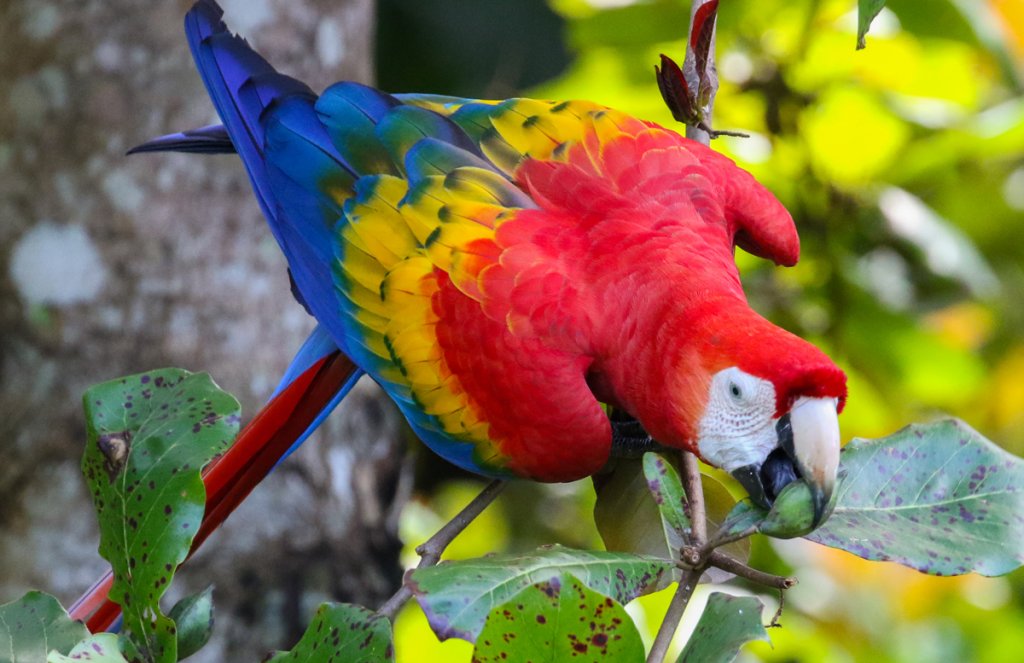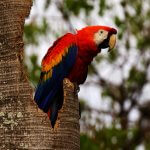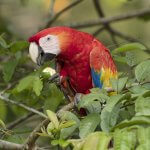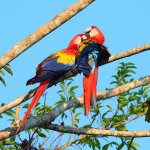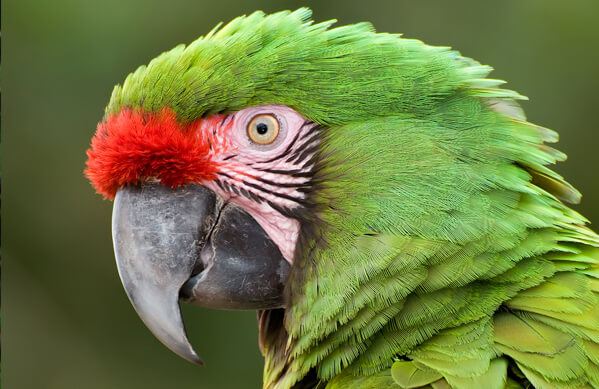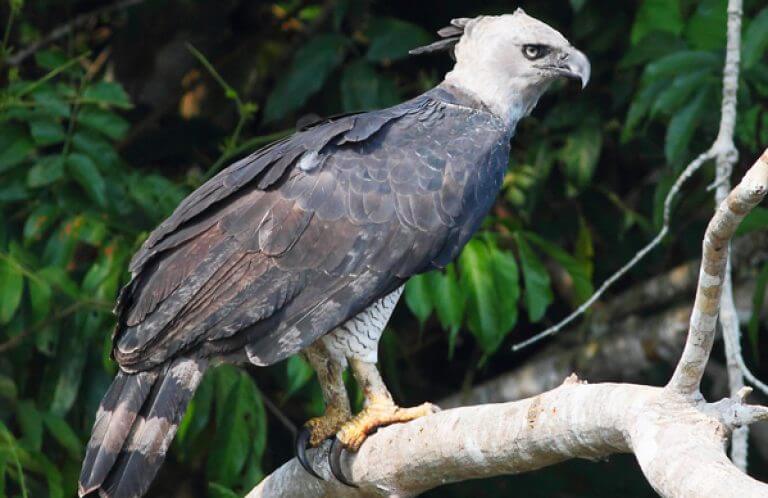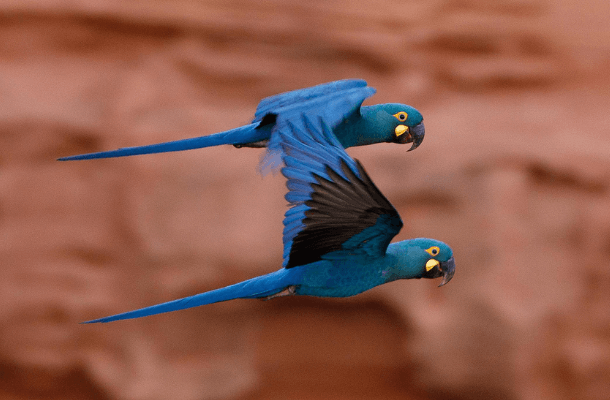About the Scarlet Macaw
For many, the eye-popping Scarlet Macaw is a bird of theme parks, zoos, and cages. In the wild, though, this three-foot-long, social, long-tailed parrot is a winged symbol of remaining wilderness, like its cousin the Great Green Macaw and the mighty Harpy Eagle.
A free-flying pair or small family flock of Scarlet Macaws is like a raucous band of flying rainbows, their tricolored upper wings dazzling banners of red, yellow, and blue. Seen from below, these birds appear all bright red, save for a few blue undertail feathers.
Worry Over a Bird of "Least Concern"
David Wiedenfeld, now ABC's Senior Conservation Scientist, formally described the northern population of the Scarlet Macaw as a distinct subspecies, Ara macao cyanoptera, in 1994.
Conservationists consider this subspecies, which occurs in isolated populations from southern Mexico to Costa Rica, to be imperiled. In 2019, the U.S. Fish and Wildlife Service listed Ara macao cyanoptera as Endangered, boosting conservation efforts for this population's habitat and helping protect it from illegal international trade.
Songs and Sounds
Scarlet Macaws emit a variety of calls when together, but the most striking and most-often-heard vocalization is a far-reaching, grating "Raaaaaak!" that sounds like a primordial scream one might imagine a pterodactyl would make.
Listen here:
Breeding and Feeding
Family Trees
Like many parrots, Scarlet Macaws are cavity nesters, laying their eggs in hollowed out spaces found in large (often huge) living or dead trees. The cavity might result from natural decay, might have been carved out by a woodpecker, or, in some cases, is excavated completely by the macaws, working in soft, rotting wood. Usually, one or two eggs are laid, and incubation takes almost a month. Once hatched, the nestlings remain in the nest cavity three to four months. Parental guidance, however, does not end when the young birds fledge: Young macaws tag along with their parents for the rest of the year, until the adults nest again. It likely takes three to four years for a young macaw to reach breeding age.
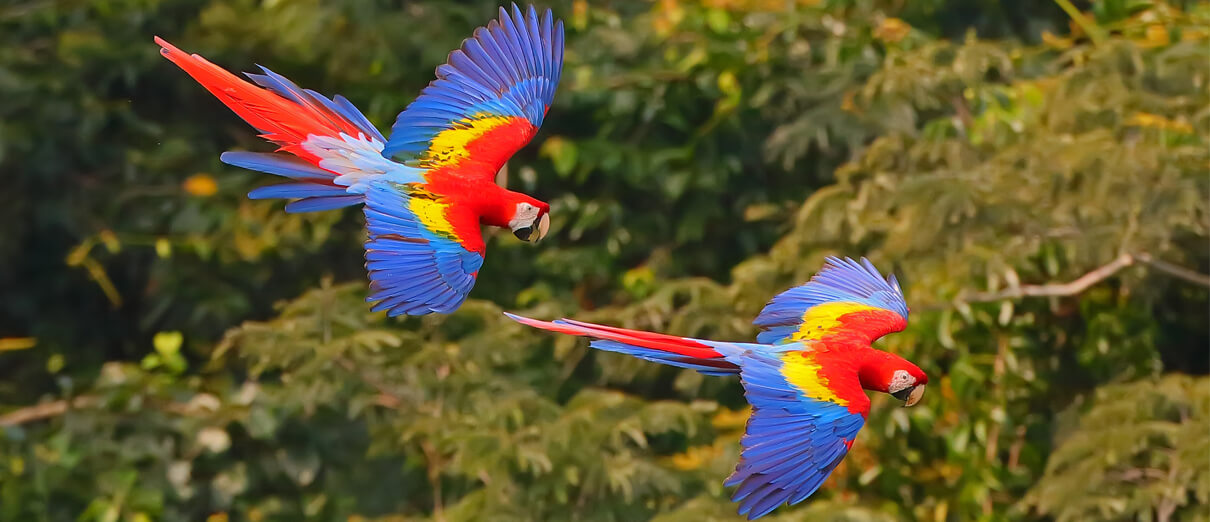
Across their wide range, Scarlet Macaws feed on a variety of wild fruits, seeds, seed pods, flowers, and even some types of bark and leaves (as is the case with ceiba or kapok trees). Some invertebrates are consumed as well. With their formidable bills, Scarlet Macaws can crush Caribbean Pine cones to get their seeds, manipulate and crack nuts (even rock-hard Brazil nuts), and chew pulp — often dropping seeds, such as those from palm fruits, which soon sprout below, making this parrot an important disperser of some trees. In some areas of South America, Scarlet Macaws and other parrots frequent specific eroding river banks, where they consume mineral-rich clay.
Region and Range
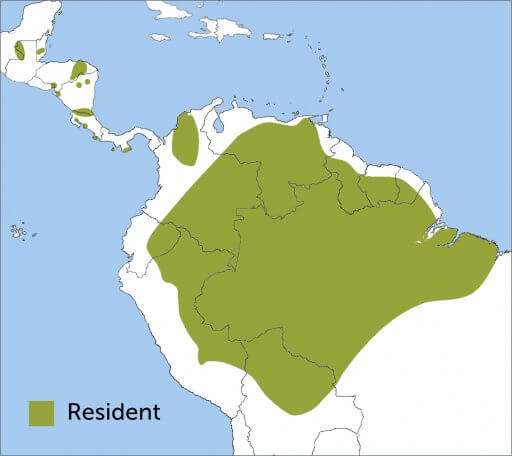
The Scarlet Macaw is virtually gone from Mexico, where it once occurred from the eastern Caribbean coast to the south of the country. Today, these birds are only reported in the Mexico-Guatemala border region, but mostly in Guatemala's Petén region. Otherwise, in Central America, populations persist in one small part of Belize and a few widely scattered areas in each of the following countries: Honduras, Nicaragua, Costa Rica, and Panama. In South America, Scarlet Macaws occur in a patch of northern Colombia and across much of Amazonia, as far south as central Bolivia, as far east as north-central Brazil, and as far west as eastern Ecuador.
In the Mosquitia region in Honduras and Nicaragua, Scarlet Macaws inhabit mixed broadleaf-and-pine forests. A few Central American populations occur in deciduous (semi-dry) forests. For the most part, though, Scarlet Macaws live in humid evergreen tropical forests and gallery forests cloaking the edges of waterways, mostly in lowlands, in some areas reaching into low foothills.
The red feathers of the Scarlet Macaw have been favored for decorations and ceremonial garments by Indigenous peoples in the Neotropics for millennia. There is evidence that the birds were traded widely in the Americas, and scientists have found evidence of the macaws as far north as New Mexico.
Conservation

Help support ABC's conservation mission!
Unfortunately, the Scarlet Macaw's bright plumage also poses its biggest threat — capture for the pet bird trade. Whenever roads and settled areas push in its habitat, it faces the additional threat of habitat loss. Unlike other dwindling species such as the Red-fronted Macaw and Lear's Macaw, this species has a wide range across northern South America. Unfortunately, though, deforestation has been increasing for decades across Amazonia along growing road networks, and Scarlet Macaw populations there are thought to be declining as well. Due to these pervasive threats, flourishing Scarlet Macaw populations are thought to mostly occur in large, roadless wilderness areas.
Get Involved
Many of the rarest bird species in the Western Hemisphere remain relatively unknown. You can learn more about these birds and the threats they face by signing up for ABC's Bird of the Week email series, which frequently highlights these fascinating birds.
American Bird Conservancy and our partners throughout Latin America and the Caribbean have created and expanded more than 100 bird reserves, which protect upward of 1.1 million acres of vital habitat. Together, we've planted more than 6.8 million trees, helping to restore degraded and damaged habitat. You can help us continue to protect endangered birds by making a gift today.





































